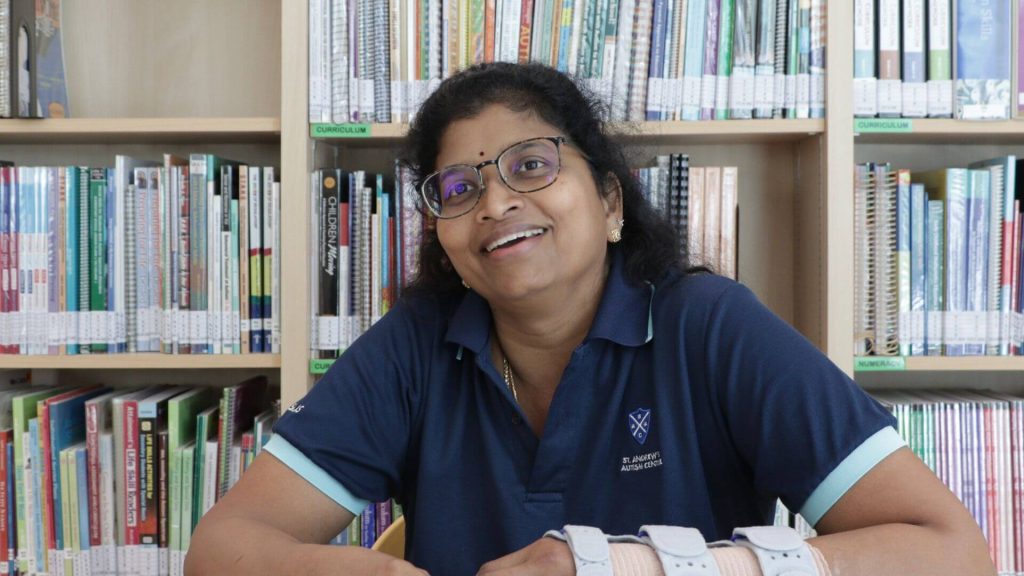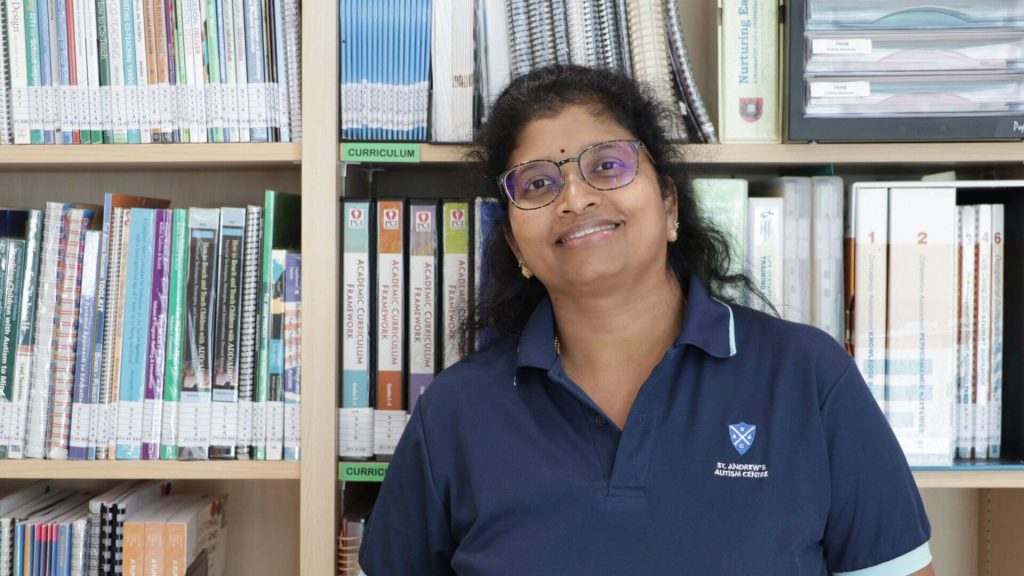Durai Pandian Visalakshi – or Visa, to her colleagues – never worked in special education before joining SAAC. Born in India, she taught social work and counselling at college before arriving in Singapore in 2001.
It was while preparing for her interview with SAAC and researching into autism, that she began to understand more about its gaps, challenges and needs, Visa admits.
“In 2005, SAAC had not started accepting students, so there was no headcount for a social worker. But I was offered a position as a therapist [subsequently teacher/therapist]. I decided to take a leap of faith and give it a shot,” she says.

So Visa became the third staff member to join SAAC, which was located in a small office in St. Andrew’s Community Hospital. After several months, it moved to a ward room in the same building.
Visa had to teach academic domains including literacy, numeracy and science, and support her colleagues in others like daily living skills and domestic science. To familiarise herself with strategies and practices to support the first batch of students, she attended numerous training programmes and workshops.
“There were 3 of them, each 17 years old or about. To cater to their specific needs and abilities, we customised learning experiences for them,” she says.
“For instance, since Tiffany was able to read, we created worksheets and printed them out for her to complete. As for Bryan, who struggled with sensory issues, we focused on dexterity hence more tearing and pasting activities.”
Powered by the passion to serve students and their families, the team worked through both morning and afternoon sessions. As there was no full-fledged curriculum to refer to, the teachers decided to write their own.
For the one she led for numeracy, Visa incorporated takeaways from her Diploma in Special Education studies, as well as good practices picked up from schools and organisations across Singapore, Australia and the US.
And to teach students about social skills, the team crafted social stories. These came with visual aids to share about daily activities such as getting dressed, washing hands, and playing with others, and included behavioural strategies.
Visa adds: “We had no smartphone apps then, so we learnt to use a camcorder to take videos of our sessions. We’d share these videos with parents or caregivers, so they could better understand the results of our intervention strategies.”
In 2011, SAAC relocated to its present premises at Elliot Road. Besides the school and two day activity centres, it also set up an adult home in 2019 to provide long-term care for its residents. It currently serves more than 460 children, youths and adults with autism.
Visa’s responsibilities have been expanded – she now teaches all domains – but she knows there’s more to be done. Besides helping to develop a social and emotional learning curriculum, she’s also part of the school’s family engagement team that seeks to foster greater parent engagement.
Autism affects more than 50,000 people in Singapore, of which 11,500 are 19 years or younger. There is no cure for the condition but early intervention can help to improve quality of life.
“My students continue to inspire me. Every child’s needs are different every day. Understanding that makes me think further about how to engage my students meaningfully and bring out their talents and skills,” Visa shares.
“I also appreciate the trust and faith of the parents and caregivers, especially those of our earliest students. Some of them have kept in touch, and continue to share about their child’s progress and to express their gratitude. It gives me strength to continue doing what I do here.”

With the Ministry of Education promising more support for the special education sector recently, Visa looks forward to further enriching her students’ lives and enabling them to lead dignified lives.
“It is very important to treat people with autism with respect. We must remember that everyone has feelings and opinions. There can be several reasons why they behave in a specific way, and there are many ways they express themselves. For example, loud and angry voices can cause a child to react adversely and experience a meltdown. So try to speak calmly and slowly to him or her,” she elaborates.
To be able to teach her students effectively, Visa believes she herself must continue learning and hone her teaching approaches. She is looking forward to more opportunities to attend courses and workshops, to find out about new strategies that she can adapt or refine for her students.
So does Visa still think about resuming her former career in social work? She replies with a chuckle: “I think my true calling was in teaching!”
If you would like explore career opportunities with SAAC’s teaching team and make a difference to our students, visit here now.







